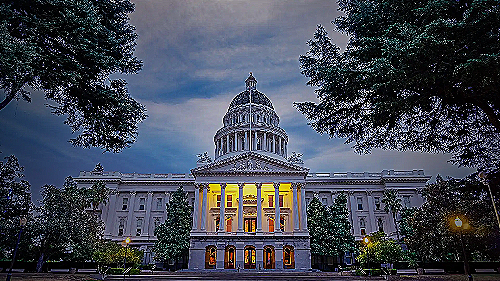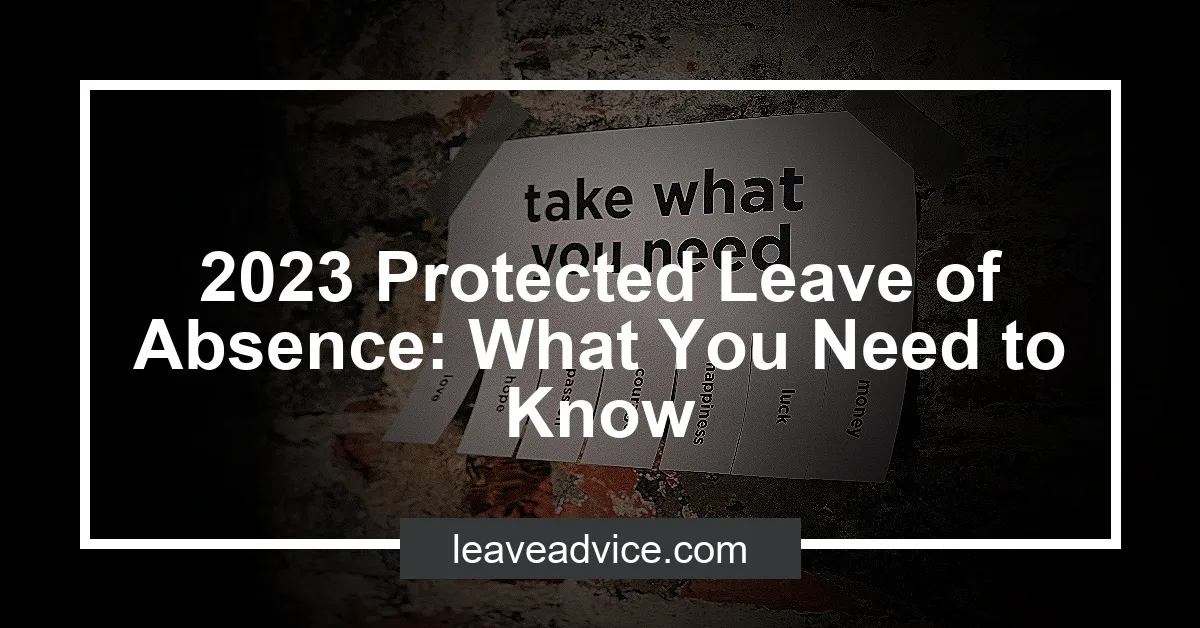2023 Protected Leave of Absence: What You Need to Know
California AB 1949: Changes in Protected Leave of Absence Regulations
The 2023 Protected Leave of Absence has brought some significant changes to California’s bereavement leave regulations. California AB 1949 amends the California Family Rights Act (CFRA) to provide covered employees who have worked for at least 30 days five days of job-protected leave for bereavement due to the death of a family member.
The law specifies that the eligible employees can take this leave within three months of the qualifying death. A qualifying death may include the death of a:
- Spouse or domestic partner
- Child
- Parent
- Sibling
- Grandparent
Employers are now required to post a notification in the workplace informing employees of their rights under the law.

This amendment is an important development in the protection of employees’ rights to mourn and grieve.
Are you struggling to understand your rights when it comes to taking a protected leave of absence? Check out this Youtube video titled “Family Medical Leave Act (FMLA) Explained by an…” to gain a better understanding and make sure you know your rights as an employee.
Overview of Protected Leave of Absence
What is Protected Leave of Absence?
Protected leave of absence is a type of leave granted to an employee by law or company policy, which enables them to take time off work without fear of losing their job or being demoted. This type of leave is available to eligible employees who may be dealing with a serious medical condition, adoption, childbirth, or other family or personal situations that require their absence from work.
Protected leave of absence is regulated by state and federal laws, including the Family and Medical Leave Act (FMLA) and the California Family Rights Act (CFRA), to ensure that employee rights are safeguarded.
Who is Eligible for Protected Leave of Absence?
Eligibility for protected leave of absence varies depending on the specific law or policy providing the leave. Generally, employees who have worked for a specific period, usually ranging from thirty (30) days to one (1) year, and have met other conditions such as the number of hours worked or the size of the employer, are eligible for protected leave of absence.
Under FMLA, for instance, employees who have worked for at least 12 months for a covered employer, have worked at least 1,250 hours during the previous 12 months, and work at a location where the employer has 50 or more employees within 75 miles, are eligible for protected leave of absence.
What are the Benefits of Protected Leave of Absence?
Protected leave of absence provides several benefits to employees, including job protection, continued health care coverage, and accrued seniority during the leave period. Job protection means that an employee who takes protected leave of absence is entitled to return to their job or an equivalent position upon their return, without risk of retaliation or termination.
Additionally, employers are required to maintain their employees’ healthcare benefits during their leave, saving them from losing or paying additional costs for their healthcare coverage. Lastly, some employers or state laws allow employees to accrue seniority and other benefits during their leave, ensuring that they do not lose critical job benefits because of their absence.
Changes to Protected Leave of Absence in 2023
The Impact of COVID-19
The COVID-19 pandemic has brought about a significant impact on various aspects of people’s lives, including the area of employment. In response to the pandemic, changes were made in protected leave of absence laws.
Starting in 2023, employees in California can take up to 12 weeks of unpaid, job-protected leave per year, which is an increase from the previous limit of 10 weeks.
Amendments to FMLA
The Family and Medical Leave Act (FMLA) is a law that provides certain employees with up to 12 weeks of unpaid, job-protected leave per year. A new change in policy is that employees who qualify for the FMLA will have the option to receive fully paid leave for up to 4 out of their 12 weeks of leave per year.
This new amendment is following in the footsteps of many other states recognizing the importance of paid family leave.
New Protections for Employees
There are also new protections for employees covered by the California Family Rights Act (CFRA) starting in 2023. California AB 1949 amends the CFRA regulations regarding protected time off for bereavement leave.
Covered employees who have worked at least 30 days are now provided five days of bereavement leave to be taken within three months of a qualifying death. This is a significant increase from the previous limit of three days of paid bereavement leave.

This new law not only provides more protection for employees experiencing bereavement but also shows the importance that California places on supporting its workers. As a result, employees can now take the necessary time off to take care of themselves and their families during challenging times.
These new policies are a step forward in promoting a better work-life balance for employees, helping support healthy families, and ultimately bolstering society as a whole.
How to File for Protected Leave of Absence
The Process of Filing for Leave
To file for a protected leave of absence, an employee should first determine if they are eligible for leave under federal or state law. The Family and Medical Leave Act (FMLA) provides eligible employees with up to 12 weeks of unpaid, job-protected leave per year for specific family or medical reasons.
Employers covered by FMLA must post a notice explaining the Act’s provisions and provide each employee with a general notice. Employees may also request leave based on other applicable federal or state laws, such as the Americans with Disabilities Act (ADA) or the Uniformed Services Employment and Reemployment Rights Act (USERRA).
Once an employee has determined their eligibility for protected leave, they must notify their employer in writing of their intention to take leave, including the reason for leave, the anticipated duration of leave, and the expected start and end dates. The employee should also request any necessary FMLA or other required forms from their human resources department.
Acceptable Reasons for Leave
Employees may take protected leave for a variety of reasons, including their own serious health condition, the birth or adoption of a child, or to care for a family member with a serious health condition. Leave may also be available to military families and for certain qualifying exigencies related to military service under FMLA.
Additionally, some states have their own family and medical leave laws that may provide additional qualifying reasons for leave.
Documentation Required for Leave
Employers may require employees to provide documentation to support their request for protected leave, such as medical certification or documentation of military service. Employees should be informed of any required documentation and given sufficient time to provide it.
To protect employee privacy, medical documentation and other sensitive information should be kept confidential and separate from an employee’s personnel file.
Managing Protected Leave of Absence
Employee Rights During Leave
Employees have certain rights during protected leave of absence. If an employee qualifies for the protected leave, they may take up to 12 weeks off per year, as per the Family and Medical Leave Act (FMLA).
This protected leave is job-protected, meaning that the employee cannot be fired due to their absence. Employers are also required to maintain the employee’s group health benefits during their absence.
However, this leave is unpaid, unless the employer provides paid leave as part of their benefits package.
Employer Obligations During Leave
Employers also have obligations during an employee’s protected leave of absence. They are required to continue providing group health benefits.
Employers must not interfere with the employee’s protected leave, and are not allowed to retaliate against employees for taking protected leave. Employers should also communicate with employees about the leave process and ensure proper documentation is maintained.
Returning to Work After Leave
After protected leave of absence, the employee is entitled to return to work in the same or an equivalent position. Employers are required to maintain the employee’s group health benefits during their absence.
If the employer changed the employee’s position, pay, or any other aspect of their employment status during their absence, the employer must offer the employee a position that is substantially similar to their previous position. Employers are required to work with employees to accommodate any work restrictions or limitations caused by their health condition.
Frequently Asked Questions
How Can I Apply for Protected Leave of Absence?
Is Protected Leave of Absence Paid?
How Long Can I Take Protected Leave of Absence?
What Happens if My Employer Violates Protected Leave of Absence?
Protected Leave of Absence Under FMLA
Protected Leave of Absence refers to the right of eligible employees to take time off from work due to their own illness, caring for a family member, or birth/adoption of a child without losing their job or health insurance benefits. The Family and Medical Leave Act (FMLA) provides such employees with up to 12 weeks of unpaid, job-protected leave every year.
During the leave, their group health benefits must also be continued.
Eligibility Criteria for Protected Leave of Absence
According to the FMLA, employees are eligible for protected leave of absence if they have worked for their employers for at least 12 months and have accrued 1,250 hours of service during those 12 months. Employers covered under the FMLA must have at least 50 employees working within a 75-mile radius to be subject to the FMLA.

